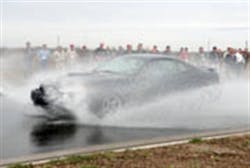The traction grades featured on the sidewall markings provide a general indication of a tire's ability to control and stop a vehicle on a wet road surface. They are the result of straight-line testing on controlled wet-surface pavements performed by the tire manufacturers themselves.
These traction ratings are established on skid pads that are designed following federal government standards. Twenty measurements are taken using an industry standard "control" tire on both an asphalt surface and a concrete surface, with the results from each surface test averaged. The same scenario is then performed with the specific tire being tested, and the results are then compared with the data obtained from the control-tire tests. The rating grade for traction is then assigned.
Because traction testing is performed in a straight-line braking scenario, traction ratings may not indicate cornering traction.
When a wedge of water prevents contact between the tire and the road surface, hydroplaning occurs. This can cause temporary directional pull and loss of control.
Virtually any vehicle and tire combination has the potential to hydroplane at various vehicle speeds. But it's important to understand that hydroplaning is caused by a combination of factors; they include vehicle speed, tread design, tread depth, tread compound, tire width, vehicle weight and water depth.
Larger profile/lower aspect ratio performance tires create a larger footprint, which may aid in dry traction because it takes advantage of more rubber on the road for increased grip. However, in wet weather, this larger footprint potentially can degrade traction because of the larger water-wedge that can be created (a narrower tire may "slice" through water better than a very wide tire). In response to this trait, tire manufacturers go to great lengths to design tread patterns and compounds that will resist hydroplaning.
[PAGEBREAK]
Speaking in very broad general terms, the following are conditions that can contribute to a greater potential for hydroplaning:
1. wider tire,
2. shallower tire tread depth,
3. higher vehicle speed,
4. lighter vehicle weight,
5. deeper water,
6. less-efficient tire tread design, and
7. insufficient tire inflation pressure.
While most drivers are aware (or should be) that tire inflation pressures are critical to safe handling, tire life and tread wear, most do not realize how inflation pressure affects wet traction. The goal, in terms of inflation pressure, is to always create the proper and maximum tread contact patch between the tire and the road surface.
In terms of tread wear, if a tire is under-inflated, the outer tread/shoulder areas will wear faster than the center tread area. If over-inflated, the tread center area will wear faster than the shoulder areas.
In terms of wet traction, an under-inflated tire simply cannot achieve proper road contact because the center tread area is not supporting its share of the vehicle load. Since the shoulders are carrying the majority of the load, the center tread area becomes slightly concave, creating a "hollow" area. This concave center tread area then welcomes water. It allows a thick water wedge to build up without giving the tread's water channeling design a chance to work properly. If the majority of the tire tread doesn't have a chance to touch the road surface, this invites hydroplaning.
[PAGEBREAK]
Once drivers understand this, it should become obvious that maintaining correct tire inflation pressure affects more than only tread wear. Insufficient pressure can have a devastating effect on wet traction.
How does the construction of the tire itself affect wet traction? Again, speaking in generalities, tread design affects wet traction (resistance to hydroplaning) at higher speeds and in deeper water. The tire's tread compound tends to affect wet traction at lower speeds and/or in shallower water, where the water "wedge" between the tire and the road tends to be less pronounced. It's common for today's performance tire manufacturers to utilize silica-enhanced compounds to improve both wet traction and to reduce a tire's rolling resistance.
In order to better resist the effects of hydroplaning, many wide performance tires (especially where Plus-Two or greater fitments are used) feature a very distinct "V" shape tread channel design intended to efficiently "pump" water out from between the tire and road.
This type of tread design can be found in many directional tires (tires designed to rotate in one specific direction) and allows water to be pushed out of the tread area outboard from the sides.
Advances in tire construction and tread design are ongoing, with tiremakers constantly striving to improve wet-road traction through exhaustive computer modeling and test-track evaluations.
Making the grade
Three grade ratings typically will appear on the tire sidewall. They represent the tire's tread wear rating, traction rating and temperature rating, in that order. The rating system is made up of three grades, or letters: A, B and C. "A" denotes the highest rating. Tire manufacturers assign one of three code letters to each of the performance characteristics following testing.




